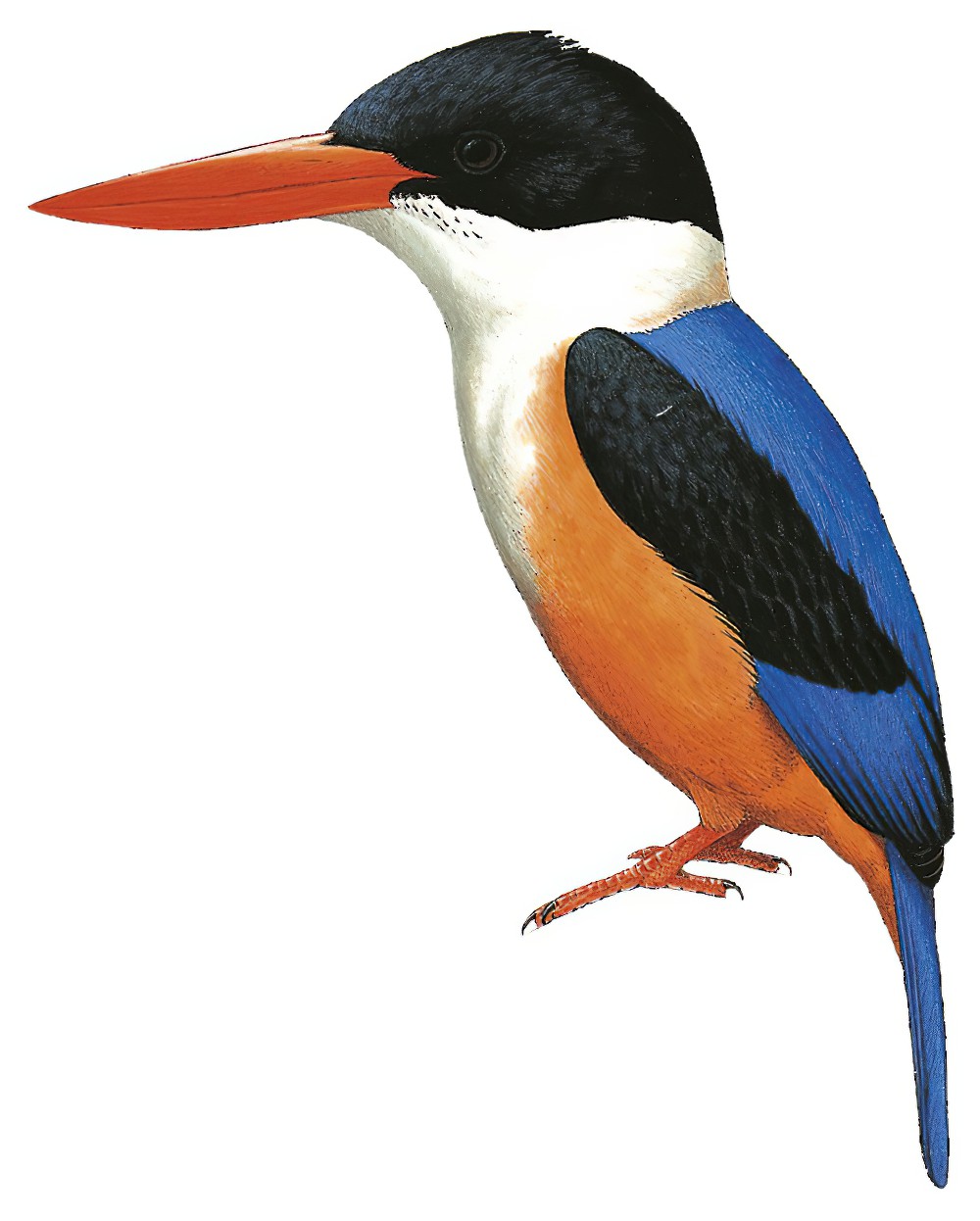Black-capped Kingfisher / Halcyon pileata

Black-capped Kingfisher
SCI Name:
Protonym: Alcedo pileata TablePlanchesEnlum. p.41
Taxonomy: Coraciiformes / Alcedinidae / Halcyon
Taxonomy Code: blckin1
Type Locality: China, ex Daubenton, PI. enlum., no. 673.
Author: Boddaert
Publish Year: 1783
IUCN Status: Least Concern
DEFINITIONS
HALCYON
(Alcedinidae; Ϯ Woodland Kingfisher H. senegalensis) Gr. αλκυων alkuōn, αλκυονος alkuonos mythical bird, long associated with the kingfisher, which nested on the sea. It was beloved of the gods, who calmed the waves whilst it incubated and raised its young, and such periods of peace and calm became known as “halcyon days”; "HALCYON collaris. Collared Crabeater. GENERIC CHARACTER. Rostrum longissimum, rectum, validum, ad basin latius quam altius, lateribus tetragonis; mandibula superiore rectissima, ad basin rotundata; inferiore carinata, recurvata, margine superioris inferiorum obtegente. Nares basales, membrana tectæ, apertura nuda, lineari obliqua. Cauda plerumque mediocris. Pedes gressorii, digito antico interiore minimo aut nullo. Typus Genericus Alcedo Senegalensis. Linn. ... REFERRING to the observations we have already made on Kingsfishers generally, it will be only necessary to observe, that the species now formed into the genus Halcyon appear entirely excluded from the American continent: their bills are much stronger, thicker, and more rounded than the genuine Kingsfishers, and the under mandible beneath invariably carinated and curving upwards. One of them (the Alcedo Senegalensis of Latham) is known to feed on crabs, the breaking and disjointing of which this structure seems admirably calculated to accomplish ... The situation of Halcyon will be between Alcedo and Dacelo; from the last of which it is distinguished by its perfectly straight, acute, and entire upper mandible, which, on the contrary, in Dacelo is notched, the tip bent and obtuse." (Swainson 1821); "Halcyon Swainson, Zool. Illustr., 1, 1820-21 (1821), text to pl. 27. Type, by original designation, Alcedo senegalensis Linné." (Peters, 1945, V, p. 193).
Var. Halcion.
Synon. Alcyon, Calialcyon, Cancrophaga, Cecilia, Ceciliella, Cedola, Chelicutia, Chelicutona, Entomobia, Entomophila, Entomothera, Halcyonopa, Nutchera, Pagurothera, Plesialcyon, Pseudhalcyon.
● (syn. Alcedo Ϯ Common Kingfisher A. atthis ispida) "Halcyon alcedo, King Fisher." (Morris 1837).
pileata / pileatum / pileatus
L. pileatus capped < pileus felt-cap.
● ex “Petit Fouquet des Philippines” of Sonnerat 1782 (syn. Anous stolidus).
● ex “Pigeon verd à tête grise d’Antigue” of Sonnerat 1776 (syn. Chalcophaps indica).
● ex “Souï” or “Petit Tinamou de Cayenne” of d’Aubenton 1765-1781, pl. 829 (syn. Crypturellus soui).
● ex “Gobe-mouche olive de Cayenne” of d’Aubenton 1765-1781, pl. 574, fig. 2 (unident;?Empidonax sp., ?Myiobius sp.).
● ex “Martin- pêcheur de la Chine” of d’Aubenton 1765-1781, pl. 673, “Martin-pêcheur à coïffe noir” of de Buffon 1770-1785, and “Black-capped Kingsfisher” of Latham 1782 (Halcyon).
● "54. PICUS. ... pileatus. 3. P. niger, capite cristato rubro, temporibus alisque albis maculis. Picus niger maximus, capite rubro. Catesb. car. 2. p. 17. t. 17. Kalm. itin. 2. p. 271. Ipecu. Marcgr. bras. 207. Habitat in America. Differt a P. cornicino, quod tempora alba; maculæ aliquot parvæ in alis albæ; caput magis late coccineum." (Linnaeus 1758) (Hylatomus).
● ex “Tangara à coëffe noire de Cayenne” of d’Aubenton 1765-1781, pl. 720, fig. 2 (Nemosia).
● ex “Tangara à coëffe noire de Cayenne” of d’Aubenton 1765-1781, pl. 720, fig. 2, “Coiffe noire” of de B uffon 1770-1783, and “Hooded Tanager” of Latham 1783 (syn. Nemosia pileata).
● ex “Black-hooded Wheat-ear” of Latham 1783 (Oenanthe).
● ex “Héron blanc huppé de Cayenne” of d’Aubenton 1765-1781, pl. 907, and “Héron blanc” of de Buffon 1770-1786 (Pilherodius).
● ex “Perruche à tête noire de Cayenne” of d’Aubenton 1765-1781, pl. 744, “Caïca” of de Buffon 1770-1783, and “Hooded Parrot” of Latham 1781 (syn. Pionopsitta caica).
● ex “Black-capped Shrike” of Latham 1787 (syn. Sakesphorus canadensis).
● ex “Pluvier du Sénégal” of d’Aubenton 1765-1781, “Pluvier coiffé” of de Buffon 1770-1786, and “Hooded Plover” of Latham 1785 (syn. Sarciophorus tectus).
● ex “Perruche de l’isle de Luçon” of Sonnerat 1776 (syn. Tanygnathus lucionensis).
● ex “Bruant du cap de Bonne-Espérance” of d’Aubenton 1765-1781, pl. 386, fig. 2, and “Bonjour-Commandeur” of de Buffon 1770-1785 (syn. Zonotrichia capensis).
Pileata
(syn. Biziura Ϯ Musk Duck B. lobata) L. pileatus capped < pileus felt-cap; "GENUS BIZIURA. — Leach. WATTLE-DUCKS. Hydrobates— Temminck. Pileata— Brown. ... The B. lobata, or Wattle-Duck, is the only species of this genus known. It is a native of Australia, locating on rivers and pools, and is never known to visit the sea. They universally associate in pairs. They dive with much rapidity, and are very difficult to shoot. Nothing is known of their habits." (T. Brown 1845).
UPPERCASE: current genus
Uppercase first letter: generic synonym
● and ● See: generic homonyms
lowercase: species and subspecies
●: early names, variants, mispellings
‡: extinct
†: type species
Gr.: ancient Greek
L.: Latin
<: derived from
syn: synonym of
/: separates historical and modern geographic names
ex: based on
TL: type locality
OD: original diagnosis (genus) or original description (species)












